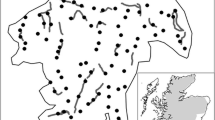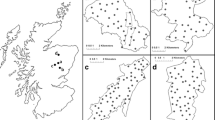Abstract
Despite their often high conservation status and international obligations to undertake regular population surveillance, the status of pine marten (Martes martes) in many countries remains poorly understood. We conducted a non-invasive survey to determine the abundance of pine marten in forested habitat located within a 360 km2 mountainous region of Northern Ireland. We deployed 126 hair tubes between June and November during which 4 sampling sessions occurred, each lasting approximately 10 days. Hair samples were collected and analysed using genetic techniques to confirm species identity, sex and provide individual identity profiles. Genotyping success rates increased with the number of hairs in a sample and were significantly greater with sample sizes of ≥10 hairs (χ 2 = 15.1, df 1, P < 0.005). Abundance estimates for the adult breeding population were 23 individuals (95 % CI 15–31). Sex ratio data were 61 % male and 39 % female, suggesting that 14 males and 9 females were present in the breeding population. The total population abundance of pine marten, including breeding adults and annual juvenile recruitment, was estimated at 32 (95 % CI 31–35). Mean pine marten density was 0.53 per km2 of forest habitat and was within the range of densities found for the species in Europe. A breeding population in the low 20’s was considered small, and further research is needed on factors that may impact on the population including habitat management, connectivity and mortality. Non-invasive surveys provided conservation relevant data within a relatively short temporal period.



Similar content being viewed by others
References
Baines D, Moss R, Dugan D (2004) Capercaillie breeding success in relation to forest habitat and predator abundance. J Appl Ecol 41:59–71
Balestrieri A, Remonti L, Frantz AC, Capelli E, Zenato M, Dettori EE, Guidali F, Prigioni C (2010) Efficacy of passive hair-traps for the genetic sampling of a low-density badger population. Hystrix 21:137–146
Birks J, Messenger J, Braithwaite T, Davison A, Brookes R, Strachan C (2005) Are Scat Surveys a Reliable Method for Assessing Distribution and Population Status of Pine Martens? In: Harrison DJ, Fuller AK, Proulx G (eds) Martens and fishers (Martes) in human-altered environments. Springer, USA, pp 235–252
Boulanger J, Himmer S, Swan C (2004) Monitoring of grizzly bear population trends and demography using DNA mark-recapture methods in the Owikeno Lake area of British Columbia. Can J Zool 82:1267–1277
Caryl FM, Quine CP, Park KJ (2012) Martens in the matrix: the importance of nonforested habitats for forest carnivores in fragmented landscapes. J Mammal 93:464–474
Chapin TG, Harrison DJ, Katnik DD (1998) Influence of landscape pattern on habitat use by American marten in an industrial forest. Conserv Biol 12:1327–1337
Chapman DG (1951) Some properties of the hypergeometric distribution with applications to zoological sample censuses. Univ Calif Publ Stat 1:131–160
Davoli F, Schmidt K, Kowalczyk R, Randi E (2013) Hair snaring and molecular genetic identification for reconstructing the spatial structure of Eurasian lynx populations. Mamm Biol 78:118–126
Efford M (2004) Density estimation in live-trapping studies. Oikos 106:598–610
Frantz AC, Schaul M, Pope LC, Fack F, Schley L, Muller CP, Roper TJ (2004) Estimating population size by genotyping remotely plucked hair: the Eurasian badger. J Appl Ecol 41:985–995
Frantz AC, Fack F, Muller CP, Roper TJ (2006) Faecal DNA typing as a tool for investigating territorial behaviour of badgers (Meles meles). Eur J Wildl Res 52:138–141
Helldin J (2000) Population trends and harvest management of pine marten Martes martes in Scandinavia. Wildl Biol 6:111–120
Helldin J, Lindström ER (1995) Late winter social activity in pine marten (Martes martes)—false heat or dispersal? Ann Zool Fenn 32:145–149
Kelly MJ, Betsch J, Wultsch C, Mesa B, Mills LS (2012) Noninvasive sampling for carnivores. In: Boitani L, Powell RA (eds) Carnivore ecology and conservation: a handbook of techniques. Oxford University Press, New York, pp 47–69
Kendall KC, McKelvey KS (2008) Hair collection. In: Long RA, Mackay P, Zielinski WJ, Ray JC (eds) Noninvasive survey methods for carnivores. Island Press, Washington DC, pp 141–182
Kopatz A, Eiken H, Hagen S, Ruokonen M, Esparza-Salas R, Schregel J, Kojola I, Smith M, Wartiainen I, Aspholm P, Wikan S, Rykov A, Makarova O, Polikarpova N, Tirronen K, Danilov P, Aspi J (2012) Connectivity and population subdivision at the fringe of a large brown bear (Ursus arctos) population in North Western Europe. Conserv Genet 13:681–692
Kurki S, Nikula A, Helle P, Linden H (1998) Abundances of red fox and pine marten in relation to the composition of boreal forest landscapes. J Anim Ecol 67:874–886
Lampa S, Henle K, Klenke R, Hoehn M, Gruber B (2013) How to overcome genotyping errors in non-invasive genetic mark-recapture population size estimation—a review of available methods illustrated by a case study. J Wild Manag 77:1490–1511
Lockie J (1964) Distribution and fluctuations of the pine marten, Martes martes (L.), in Scotland. J Anim Ecol 33:349–356
Lukacs PM, Burnham KP (2005) Review of capture–recapture methods applicable to noninvasive genetic sampling. Mol Ecol 14:3909–3919
Lynch Á, Brown M (2006) Molecular sexing of pine marten (Martes martes): how many replicates. Mol Ecol 6:631–633
Lynch ÁB, McCann Y (2007) The diet of the pine marten (Martes martes) in Killarney National Park. Biol Environ 107B:67–76
Lynch Á, Brown M, Rochford J (2006) Fur snagging as a method of evaluating the presence and abundance of a small carnivore, the pine marten (Martes martes). J Zool 270:330–339
Manzo E, Bartolommei P, Rowcliffe JM, Cozzolino R (2012) Estimation of population density of European pine marten in central Italy using camera trapping. Acta Theriol 57:165–172
Mergey M, Helder R, Roeder JJ (2011) Effect of forest fragmentation on space-use patterns in the European pine marten (Martes martes). J Mammal 92:328–335
Miller R, Ritcey R, Edwards R (1955) Live-trapping marten in British Columbia. Murrelet 36:1–8
Miller CR, Joyce P, Waits LP (2005) A new method for estimating the size of small populations from genetic mark–recapture data. Mol Ecol 14:1991–2005
Mills LS, Citta JJ, Lair KP, Schwartz MK, Tallmon DA (2000) Estimating animal abundance using noninvasive DNA sampling: promise and pitfalls. Ecol Appl 10:283–294
Mowat G, Paetkau D (2002) Estimating marten Martes americana population size using hair capture and genetic tagging. Wildl Biol 8:201–209
Mowat G, Strobeck C (2000) Estimating population size of grizzly bears using hair capture, DNA profiling, and mark-recapture analysis. J Wild Manag 64:183–193
Mullins J, Statham MJ, Roche T, Turner PD, O’Reilly C (2010) Remotely plucked hair genotyping: a reliable and non-invasive method for censusing pine marten (Martes martes, L. 1758) populations. Eur J Wildl Res 56:443–453
O’Mahony DT (2014) Socio-spatial ecology of pine marten (Martes martes) in conifer forests, Ireland. Acta Theriol 59:251–256
O’Mahony D, O’Reilly C, Turner P (2012) Pine marten (Martes martes) distribution and abundance in Ireland: a cross-jurisdictional analysis using non-invasive genetic survey techniques. Mamm Biol 77:351–357
O'Sullivan P (1983) The distribution of the Pine marten (Martes martes) in the Republic of Ireland. Mamm Rev 13:39–44
Otis DL, Burnham KP, White GC, Anderson DR (1978) Statistical inference from capture data on closed animal populations. Wildl Monogr 62:1–135
Pauli JN, Whiteman JP, Marcot BG, McClean TM, Ben-David M (2011) DNA-based approach to aging martens (Martes americana and M. caurina). J Mammal 92:500–510
Peakall ROD, Smouse PE (2006) GENALEX 6: genetic analysis in Excel. Population genetic software for teaching and research. Mol Ecol 6:288–295
Piggott MP (2004) Effect of sample age and season of collection on the reliability of microsatellite genotyping of faecal DNA. Wildl Res 31:485–493
Poole KG, Mowat G, Fear DA (2001) DNA-based population estimate for grizzly bears Ursus arctos in northeastern British Columbia, Canada. Wildl Biol 7:105–115
Proulx G, Aubry K, Birks JDS, Buskirk S, Fortin C, Frost H, Krohn W, Mayo L, Monakhov V, Payer D, Saeki M, Santos-Reis M, Weir R, Zielinski W (2005) World Distribution and Status of the Genus Martes in 2000. In: Harrison DJ, Fuller AK, Proulx G (eds) Martens and fishers (Martes) in human-altered environments. Springer, USA, pp 21–76
Rogers A (1959) Pine marten, Martes martes (L.) in Co. Down woods. Ir Nat J 13:42
Ruiz-González A, Madeira MJ, Randi E, Urra F, Gómez-Moliner BJ (2013) Non-invasive genetic sampling of sympatric marten species (Martes martes and Martes foina): assessing species and individual identification success rates on faecal DNA genotyping. Eur J Wildl Res 59:371–386
Shaffer ML (1981) Minimum population sizes for species conservation. Bioscience 31:131–134
Sheehy E, O’Meara DB, O’Reilly C, Smart A, Lawton C (2014) A non-invasive approach to determining pine marten abundance and predation. Eur J Wildl Res 60:223–236
Shuttleworth CM, Lurz PWW, Geddes N, Browne J (2012) Integrating red squirrel (Sciurus vulgaris) habitat requirements with the management of pathogenic tree disease in commercial forests in the UK. For Ecol Manag 279:167–175
Vergara M, Ruiz-González A, López de Luzuriaga J, Gómez-Moliner BJ (2014) Individual identification and distribution assessment of otters (Lutra lutra) through non-invasive genetic sampling: recovery of an endangered species in the Basque Country (Northern Spain). Mamm Biol 79:259–267
Wasserman TN, Cushman SA, Schwartz MK, Wallin DO (2010) Spatial scaling and multi-model inference in landscape genetics: Martes americana in northern Idaho. Landsc Ecol 25:1601–1612
White GC, Anderson DR, Burnham KP, Otis DL (1982) Capture-recapture and removal methods for sampling closed populations. Los Alamos Natl Lab USA 1–230
Witmer GW (2005) Wildlife population monitoring: some practical considerations. Wildl Res 32:259–263
Zalewski A, Jędrzejewski W (2006) Spatial organisation and dynamics of the pine marten Martes martes population in Białowieza Forest (E Poland) compared with other European woodlands. Ecography 29:31–43
Acknowledgments
This study was funded by a grant from the Peoples Trust for Endangered Species and the Northern Ireland Environment Agency. The Forest Service of Northern Ireland provided considerable logistical support to the project including a permit to work in their forests. Graham Cherry (AFBI) undertook substantial field work for the project and his contribution is gratefully acknowledged. Two anonymous referees improved the manuscript and their contribution is acknowledged.
Author information
Authors and Affiliations
Corresponding author
Additional information
Communicated by C. Gortázar
Rights and permissions
About this article
Cite this article
O’Mahony, D.T., Turner, P. & O’Reilly, C. Pine marten (Martes martes) abundance in an insular mountainous region using non-invasive techniques. Eur J Wildl Res 61, 103–110 (2015). https://doi.org/10.1007/s10344-014-0878-0
Received:
Revised:
Accepted:
Published:
Issue Date:
DOI: https://doi.org/10.1007/s10344-014-0878-0




